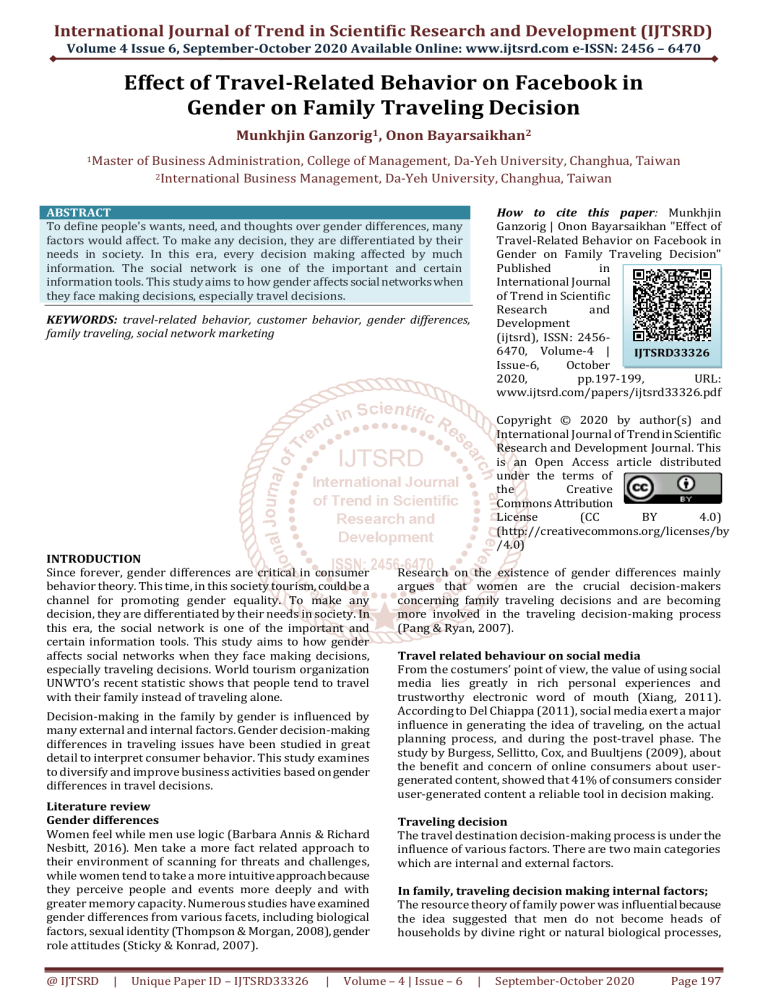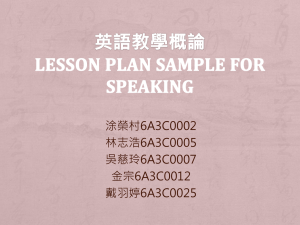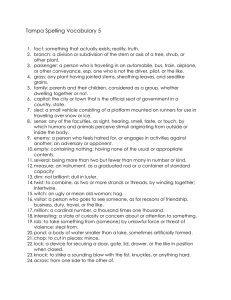
International Journal of Trend in Scientific Research and Development (IJTSRD)
Volume 4 Issue 6, September-October 2020 Available Online: www.ijtsrd.com e-ISSN: 2456 – 6470
Effect of Travel-Related Behavior on Facebook in
Gender on Family Traveling Decision
Munkhjin Ganzorig1, Onon Bayarsaikhan2
1Master
of Business Administration, College of Management, Da-Yeh University, Changhua, Taiwan
2International Business Management, Da-Yeh University, Changhua, Taiwan
ABSTRACT
To define people's wants, need, and thoughts over gender differences, many
factors would affect. To make any decision, they are differentiated by their
needs in society. In this era, every decision making affected by much
information. The social network is one of the important and certain
information tools. This study aims to how gender affects social networks when
they face making decisions, especially travel decisions.
How to cite this paper: Munkhjin
Ganzorig | Onon Bayarsaikhan "Effect of
Travel-Related Behavior on Facebook in
Gender on Family Traveling Decision"
Published
in
International Journal
of Trend in Scientific
Research
and
Development
(ijtsrd), ISSN: 24566470, Volume-4 |
IJTSRD33326
Issue-6,
October
2020,
pp.197-199,
URL:
www.ijtsrd.com/papers/ijtsrd33326.pdf
KEYWORDS: travel-related behavior, customer behavior, gender differences,
family traveling, social network marketing
INTRODUCTION
Since forever, gender differences are critical in consumer
behavior theory. This time, in this society tourism, could be a
channel for promoting gender equality. To make any
decision, they are differentiated by their needs in society. In
this era, the social network is one of the important and
certain information tools. This study aims to how gender
affects social networks when they face making decisions,
especially traveling decisions. World tourism organization
UNWTO’s recent statistic shows that people tend to travel
with their family instead of traveling alone.
Decision-making in the family by gender is influenced by
many external and internal factors. Gender decision-making
differences in traveling issues have been studied in great
detail to interpret consumer behavior. This study examines
to diversify and improve business activities based on gender
differences in travel decisions.
Literature review
Gender differences
Women feel while men use logic (Barbara Annis & Richard
Nesbitt, 2016). Men take a more fact related approach to
their environment of scanning for threats and challenges,
while women tend to take a more intuitive approach because
they perceive people and events more deeply and with
greater memory capacity. Numerous studies have examined
gender differences from various facets, including biological
factors, sexual identity (Thompson & Morgan, 2008), gender
role attitudes (Sticky & Konrad, 2007).
@ IJTSRD
|
Unique Paper ID – IJTSRD33326
|
Copyright © 2020 by author(s) and
International Journal of Trend in Scientific
Research and Development Journal. This
is an Open Access article distributed
under the terms of
the
Creative
Commons Attribution
License
(CC
BY
4.0)
(http://creativecommons.org/licenses/by
/4.0)
Research on the existence of gender differences mainly
argues that women are the crucial decision-makers
concerning family traveling decisions and are becoming
more involved in the traveling decision-making process
(Pang & Ryan, 2007).
Travel related behaviour on social media
From the costumers’ point of view, the value of using social
media lies greatly in rich personal experiences and
trustworthy electronic word of mouth (Xiang, 2011).
According to Del Chiappa (2011), social media exert a major
influence in generating the idea of traveling, on the actual
planning process, and during the post-travel phase. The
study by Burgess, Sellitto, Cox, and Buultjens (2009), about
the benefit and concern of online consumers about usergenerated content, showed that 41% of consumers consider
user-generated content a reliable tool in decision making.
Traveling decision
The travel destination decision-making process is under the
influence of various factors. There are two main categories
which are internal and external factors.
In family, traveling decision making internal factors;
The resource theory of family power was influential because
the idea suggested that men do not become heads of
households by divine right or natural biological processes,
Volume – 4 | Issue – 6
|
September-October 2020
Page 197
International Journal of Trend in Scientific Research and Development (IJTSRD) @ www.ijtsrd.com eISSN: 2456-6470
but because they have more and easier access to educational,
financial, and occupational resources in society. The idea
suggested that opening up women’s access to resources
outside the family could result in a more evenly balanced
distribution of power within the family.
In family, traveling decision making external factors;
Social media are playing an increasingly important role as
information sources for travelers. Microblogging (Twitter),
video sharing (Youtube), photosharing (Facebook,
Instagram), travel-specific websites (Tripadvisor) are now
major tools in the travelers’ decision process.
Methodology
Research framework
Hypotheses 1
Hypotheses 2
Hypotheses 3
Hypotheses 4
: Gender difference has significantly effect on family travelling decision.
: Gender differences significantly has effect on the travel related behaviour on Facebook
: Travel related behaviour on FB has significantly effect on family travelling decision
: Travel related behaviour on Facebook has significantly moderating effect on gender difference and travelling
decision.
This study is measured by 3 variables that affect the Family traveling decision. The dependent variable in this study is the
family traveling decision, the independent variable is gender differences, and the mediation variable is travel related behavior
on Facebook The questionnaire has three parts. The first part involves items related to the sociodemographic profile of the
respondents (gender, age, education, employment, monthly income, place of residence, and marital status) as well as their
travel behavior.
The second part of the questionnaire includes questions about gender-related aspects and habits related to their usage of
Facebook, how Facebook gives travel motivation. The questionnaire measured by using a 7-point Likert scale (1- the least
important, 7- the most important reason).
The third part of the questionnaire includes the questions referring to respondents’ family decision making factors.
Data collection and procedures
The survey collected using an online survey (Google Docs). Respondents filled out an online questionnaire through Facebook
messenger. The respondents are voluntary and anonymous, which means random sampling. Data were sent to over 2000
participants. There were 364 invalid responses out of 1128 completed responses.
Measurement
The statistics of respondents show that most respondents were age between 18-28 (38.2%) and age between 28-38 (22.6%).
Gender was female 462 (60.5%), male 302 (39.5%), marital status was married 588 (77.0%), and single or divorced 176
(23.0%). The below chart shows the respondents' brief results.
Measure
Item
Below 18
18-28
28-38
38-48
Above 48
Female
Male
Married
Divorced/single
Age
Gender
Status
@ IJTSRD
|
Unique Paper ID – IJTSRD33326
|
Volume – 4 | Issue – 6
Respondent number
27
292
173
151
121
462
302
588
176
|
September-October 2020
Percentage
3.5%
38.2%
22.6%
19.8%
15.8%
60.5%
39.5%
77.0%
23.0%
Page 198
International Journal of Trend in Scientific Research and Development (IJTSRD) @ www.ijtsrd.com eISSN: 2456-6470
How many hour do you use a social network a day
How often do you travel /domestic, international/
Less than half hour
0,5- 1 hour
1-2 hours
More than 2 hours
Once a year
Twice a year
More than 3 times a year
55
274
355
77
269
376
129
7.2%
35.9%
46.5%
10.1%
35.2%
49.2%
16.9%
The hypotheses of the research model were tested using ANOVA and multiple regression equations provided by the SPSS
computer program.
Conclusion
To make any decision, they are differentiated by their needs
in society. In this era, every decision making affected by
much information. A social network is one of the important
and certain information tools. This study aims to how gender
affects the social network when they face making decisions,
especially traveling decisions. Data collected from
respondents show below result:
Hypothesis
H1
H2
H3
H4
Result
Not supported
Supported
Supported
Supported
|
Unique Paper ID – IJTSRD33326
Fewer Mongolians travel abroad. There are many reasons for
this one. One of the reasons is traveling abroad costs higher.
On the other side, a traveling agency and companies have a
lack of experience. This study attempt to contribute to
Mongolian tourists companies’ development by studying
gender decision on a social network to make traveling
decision.
Reference
[1] Barbara Annis & Richard Nesbitt, (2016), Using Gender
Intelligence to Create Breakthrough Growth.
Since the 2000s, the tourism industry has been growing and
has brought its benefit to the country. Mongolia’s travel and
tourism sector directly contributed to almost 4% of the GDP.
As economic growth being more stable, people’s life getting
better. This is one of the factors that lead to the tourism
industry’s development. However, tourism is still a new
concept in Mongolia, even though many companies exist in
the market. Mostly, Mongolian tourist companies are
running their business to attract foreign tourists into the
country. Because the companies believe that the only source
of revenue is from outside of the border. But they still cannot
@ IJTSRD
see opportunities to expand their business based on local
consumers.
|
[2] Burgess, Sellitto, Cox, and Buultjens (2009), Usergenerated content (UGC) in tourism: Benefits and
concerns of online consumers
[3] Del Chiappa (2011), Trustworthiness of Travel 2.0
applications and their influence on tourist behaviour:
an empirical investigation in Italy
[4] Thompson & Morgan, (2008), "Mostly straight" young
women: variations in sexual behavior and identity
development
[5] Sticky & Konrad, (2007), Gender and Racial
Differentials in Promotions
Volume – 4 | Issue – 6
|
September-October 2020
Page 199




